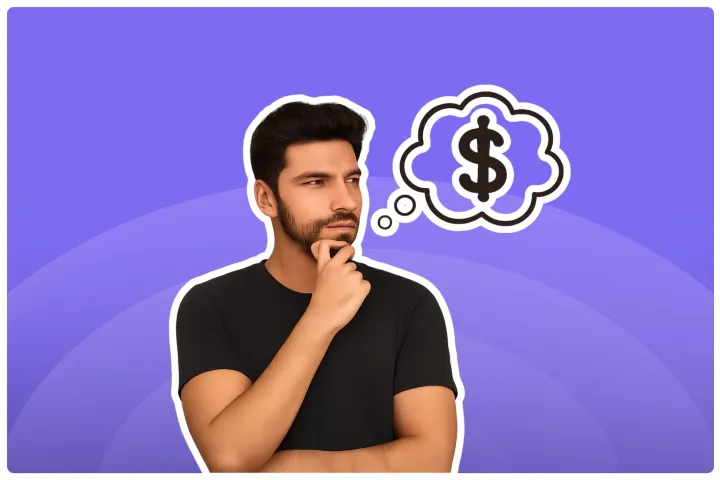Which Tool Is Commonly Used For Influencer Marketing?
Curious about influencer marketing tools? Explore the most popular options that can help you connect with the right influencers for your brand.

You know Instagram is a powerhouse for connecting with audiences, and influencers are your key allies. But let's be real: managing it all manually can feel like juggling flaming torches while riding a unicycle. 🥵 That is where the magic of dedicated tools comes in.
This guide will walk you through why leaning on technology isn't just a nice-to-have, but often a must-have for effective Instagram influencer marketing. We'll look at different types of tools, spotlight a smart AI-powered option called ryme.ai, and help you figure out the best fit for your brand. Ready to streamline your efforts and boost those results? Let's go!
Why Rely on Tools for Instagram Influencer Marketing?
Doing influencer marketing manually on Instagram might seem straightforward at first. You scroll, you DM, you track in a spreadsheet... right? But as you scale even slightly, the cracks start to show. It quickly becomes less about creative collaboration and more about administrative headaches.
Think about your current process. Does any of this sound familiar?
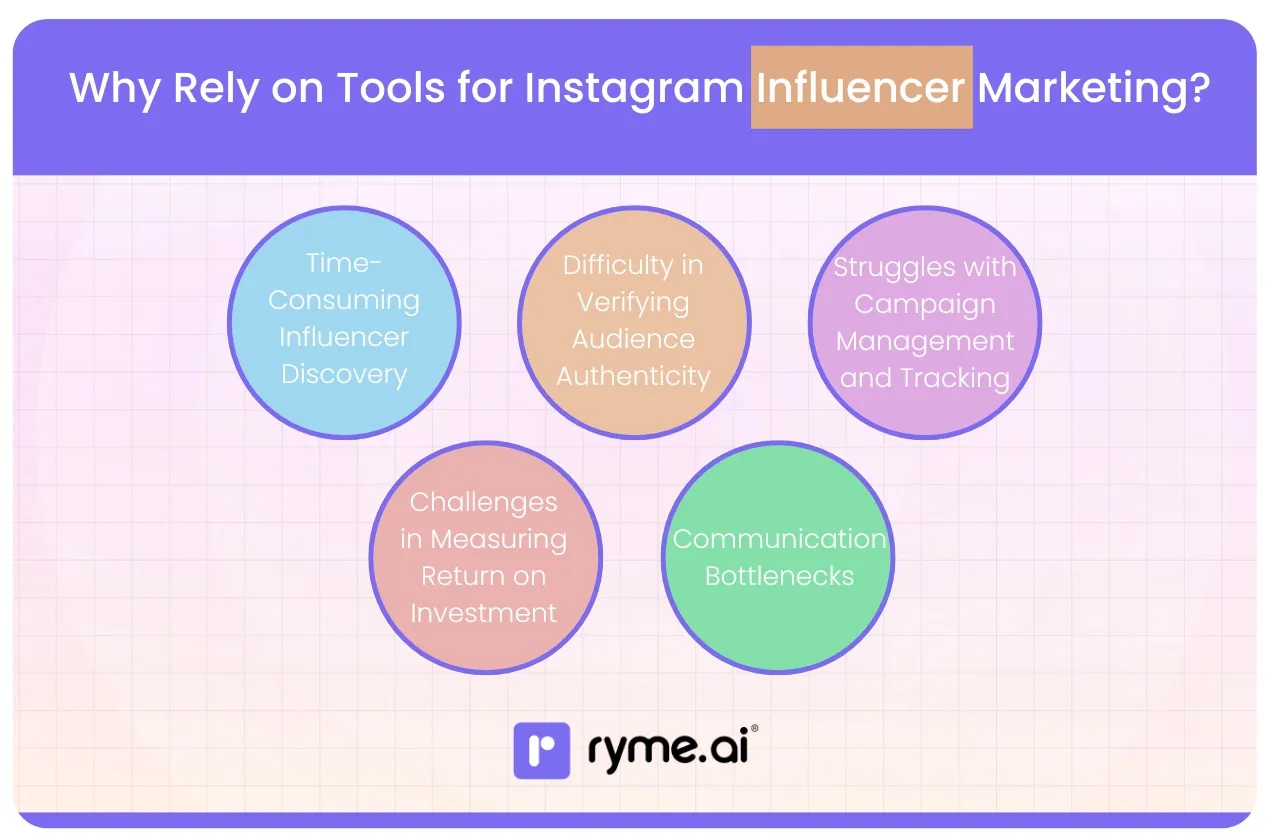
1) The Endless Scroll: Time-Consuming Influencer Discovery
Finding the right influencers is crucial. Not just someone with lots of followers, but someone whose audience genuinely aligns with your brand and whose values resonate. Manually? This means endless hours scrolling through hashtags, checking follower lists of accounts you like, diving deep into profiles, and trying to gauge authenticity.
You might spend days, even weeks, just identifying a handful of potential partners. That's time your team could be spending on strategy, creative briefs, or relationship building. It's inefficient and, frankly, exhausting. 😩
2) Spotting the Fakes: Difficulty in Verifying Audience Authenticity
You've found an influencer with impressive numbers. But how many of those followers are real, engaged humans, and how many are bots or inactive accounts? Manually vetting an audience is incredibly tough. You can look at engagement rates (likes/comments vs. followers), check the quality of comments (are they generic like "Nice pic!" or actual conversations?), and maybe use some free, basic online checkers.
But these methods are often inaccurate and don't give you the full picture of audience demographics (location, age, interests) – information vital for ensuring you're reaching your target customer. Investing budget in an influencer whose audience isn't genuine is like throwing money down the drain. 💸
3) Spreadsheet Overload: Struggles with Campaign Management and Tracking
Okay, you've found influencers. Now comes managing the campaign. Briefing multiple influencers, tracking content deadlines, handling approvals, ensuring FTC disclosures are included, processing payments... doing this via email and spreadsheets gets chaotic fast.
Imagine juggling communication threads with ten different influencers for one campaign! Information gets lost, deadlines slip, approvals become bottlenecks, and ensuring everyone posts the right content at the right time feels like herding cats. Your spreadsheet, once a symbol of organization, quickly becomes a source of stress.
4) The ROI Mystery: Challenges in Measuring Return on Investment
This is a big one. How do you actually know if your influencer campaign is working? Sure, you can track likes and comments. But how does that translate to business goals like website traffic, leads, or sales? Manually tracking this often involves asking influencers for screenshots of their analytics (which isn't always reliable or timely), setting up complex UTM parameters for every single link, and trying to piece together data from different sources.
Calculating a clear ROI becomes a complex puzzle, making it hard to justify budget or optimize future campaigns. According to research firm Influencer Marketing Hub's 2023 benchmark report, while ROI measurement is improving, nearly 23% of marketers still find it challenging to measure the ROI of their influencer campaigns effectively. This lack of clarity hinders strategic decision-making.
5) Lost in Translation: Communication Bottlenecks
Back-and-forth emails, DMs across platforms, chasing influencers for feedback or content drafts – manual communication is prone to delays and misunderstandings. Keeping track of different conversation threads, ensuring everyone has the latest information, and getting timely responses can significantly slow down your campaign launch and execution.
A simple content approval can turn into a week-long email chain. This inefficiency not only wastes time but can also strain relationships with your influencer partners.
The Upside: Why Tools Are Your Best Friend
Now, imagine swapping that manual chaos for streamlined efficiency. Dedicated influencer marketing tools are designed specifically to tackle these challenges head-on. Here’s how they help:
1) Supercharged Efficiency: Increased Time Savings
Tools automate the tedious tasks. Influencer discovery platforms use algorithms and filters to find relevant influencers in minutes, not days. Campaign management platforms centralize communication and workflows. Analytics tools gather data automatically. This frees up your team's valuable time to focus on higher-level strategy, creative planning, and building stronger influencer relationships. Think hours saved each week! ✨
2) Precision Targeting: Improved Influencer Selection
Forget guesswork. Tools provide deep insights into an influencer's audience demographics, authenticity scores (detecting fake followers), engagement metrics, and past campaign performance. You can filter searches based on niche, location, audience age, interests, and more. This data-driven approach ensures you partner with influencers whose audience truly matches your target customer profile, leading to more impactful campaigns.
3) Smooth Sailing: Enhanced Campaign Management and Organization
Imagine a central dashboard for everything: campaign briefs, content submissions, approval workflows, communication logs, payment schedules. Campaign management tools bring order to the chaos. Everyone (your team and the influencers) knows what needs to be done, by when. This structure prevents missed deadlines, reduces errors, and keeps your campaigns running smoothly from start to finish. ✅
4) Know Your Numbers: Better Performance Tracking and Analytics
Tools take the mystery out of measurement. They integrate with social media APIs (like Instagram's) to pull real-time data on reach, impressions, engagement, clicks, conversions, and more. Many offer customizable dashboards and automated reports, making it easy to see what's working, what's not, and calculate your campaign ROI accurately.
This allows for data-backed decisions and continuous optimization. 📈 Statista data from 2023 shows that influencer marketing spend continues to rise globally, projected to reach nearly $34 billion by 2024. Further industry forecasts, such as those from Brandwatch, predict the market will expand to $41.8 billion in 2025, emphasizing the need for robust tracking to justify this investment.
5) Clear Connections: Streamlined Communication and Collaboration
Most platforms offer built-in communication features, keeping all campaign-related conversations in one place. This avoids lost DMs or buried emails. Features like content preview and approval workflows mean feedback is clear, trackable, and efficient. Some tools even facilitate contract management and payments, further simplifying the process. Better communication leads to happier influencers and smoother campaigns. 🤝
Using tools transforms influencer marketing from a potentially overwhelming manual task into a strategic, measurable, and scalable marketing channel. It empowers your brand to work smarter, not harder.
Looking at the Different Kinds of Influencer Marketing Tools
Okay, so you're convinced tools can help. But walking into the 'influencer tool store' can feel a bit daunting. There are so many options! They generally fall into a few main categories, each designed to solve specific problems. Let's break them down:
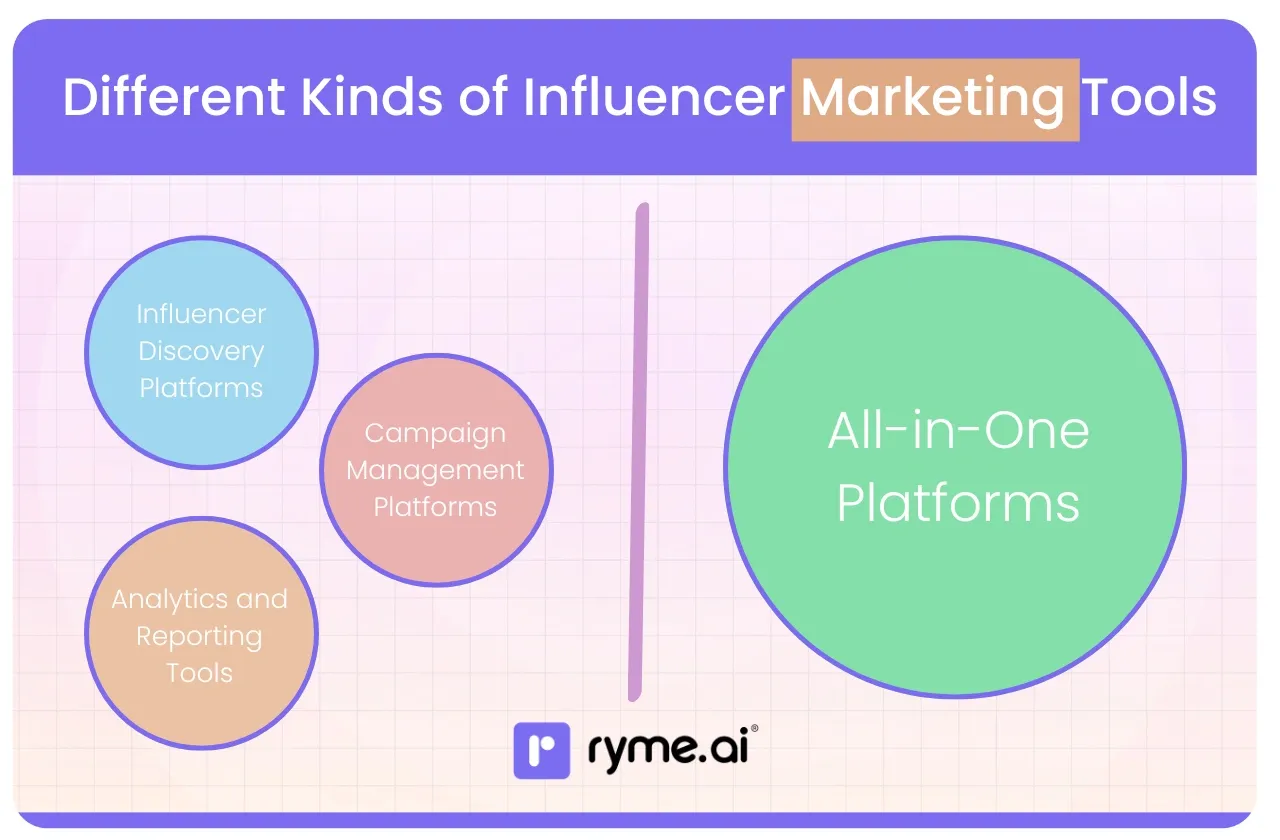
A) Influencer Discovery Platforms: Your Matchmaking Service
What they are: Think of these as specialized search engines for influencers. Their main job is to help you find and vet potential partners based on criteria that matter to your brand. They maintain vast databases of influencers across various niches and platforms, especially Instagram.
Common Features:
- Advanced Search Filters: Go beyond simple keyword searches. Filter by niche (beauty, tech, food, travel), follower count, location, audience demographics (age, gender, location, interests), engagement rate, platform (Instagram, YouTube), keywords in bio, and more.
- Audience Analysis: This is key! These tools dig into an influencer's followers. They show you breakdowns of audience age, gender, location, interests, and sometimes even income level or brand affinities. Crucially, they help assess audience quality.
- Fake Follower Detection: Many platforms have algorithms to estimate the percentage of an influencer's audience that might be bots, inactive accounts, or mass followers, giving you an authenticity score. This helps avoid wasting budget on inflated numbers.
- Influencer Profiles: Detailed profiles showcasing an influencer's content, key stats, past brand collaborations, estimated pricing (sometimes), and audience data all in one place.
- Contact Information/Outreach: Some platforms provide verified contact details or even allow you to initiate outreach directly through the platform.
Use Case: Perfect if your primary challenge is finding the right influencers. Ideal for brands just starting with influencer marketing or those looking to expand their pool of collaborators beyond their immediate network. If you spend hours scrolling Instagram hoping to stumble upon the perfect match, a discovery platform is your time-saver.
B) Campaign Management Platforms: Your Campaign Command Center
What they are: Once you've found your influencers, these tools step in to manage the entire campaign lifecycle, from the initial brief to the final payment and reporting. They organize the workflow and keep everything (and everyone) on track.
Common Features:
- Campaign Planning & Briefing: Create detailed campaign briefs within the platform, outlining goals, deliverables, messaging guidelines, do's and don'ts, and timelines. Share these easily with selected influencers.
- Content Collaboration & Approval: Influencers can submit draft content (posts, Stories, Reels descriptions) directly through the platform. Your team can review, provide feedback, request revisions, and give final approval – all logged in one place. No more messy email chains!
- Automated Workflows & Scheduling: Set up automated reminders for deadlines (content submission, posting dates). Some tools might integrate with scheduling platforms or allow influencers to schedule posts once approved.
- Communication Hub: Centralized messaging features to communicate with individual influencers or groups involved in a campaign.
- Payment Management: Streamline influencer payments. Some platforms integrate with payment systems or help track payment statuses.
- Basic Performance Tracking: Often includes tracking of live content, basic engagement metrics, and link clicks associated with the campaign.
Use Case: Essential if you're running multiple campaigns simultaneously or working with several influencers on a single complex campaign. If your pain points are missed deadlines, chaotic communication, and tracking deliverables, a management platform brings much-needed structure and efficiency.
C) Analytics and Reporting Tools: Your Performance Scoreboard
What they are: These tools are laser-focused on measuring the impact of your influencer marketing efforts. They go deep into the data to tell you what worked, what didn't, and how your campaigns contribute to your overall business goals.
Common Features:
- Comprehensive Metrics Tracking: Connect directly to social media APIs (like Instagram's) to automatically pull data on reach, impressions, engagement (likes, comments, shares, saves), video views, story views, swipe-ups, clicks, and sometimes even conversions (if integrated with your e-commerce or web analytics).
- ROI Calculation: Help you calculate the return on your investment by comparing campaign costs against outcomes (like attributed sales, leads generated, or earned media value).
- Audience Overlap Analysis: See how much audience overlap exists between different influencers you work with.
- Competitor Analysis: Some tools allow you to track competitor influencer activities or benchmark your performance against industry standards.
- Customizable Dashboards & Reports: Visualize data in easy-to-understand dashboards. Generate automated, shareable reports for stakeholders, highlighting key performance indicators (KPIs) and insights.
- Content Performance Analysis: Identify which pieces of content (posts, Stories, Reels) performed best, which influencers drove the most engagement or clicks, etc.
Use Case: Crucial for any brand that is serious about data-driven marketing. If you need to prove the value of influencer marketing, justify budget spend, understand what resonates with your audience, and continuously optimize your campaigns for better results, an analytics tool is indispensable.
D) All-in-One Platforms: Your Swiss Army Knife
What they are: As the name suggests, these platforms aim to be a one-stop shop, combining features from discovery, campaign management, and analytics into a single, integrated solution. They offer end-to-end functionality for your influencer marketing program.
Common Features: They typically bundle a broad range of features, including:
- Influencer search and vetting tools.
- Relationship management (CRM-like features for tracking influencer interactions).
- Campaign workflow management (briefing, content approvals, scheduling).
- Built-in communication tools.
- Performance tracking, analytics, and reporting dashboards.
- Payment processing or tracking.
- Sometimes includes features like content libraries or competitor tracking.
Use Case: Often appealing for brands, especially mid-size to larger ones, that want a centralized system to manage all aspects of their influencer marketing without juggling multiple subscriptions and platforms. They can offer convenience and potentially better data integration across the entire campaign lifecycle.
However, they might sometimes be less specialized in one particular area (e.g., discovery) compared to a dedicated tool, and can represent a higher initial investment.
Understanding these categories helps you identify what type of solution best matches your immediate needs and long-term goals for Instagram influencer marketing.
ryme.ai: An AI-Powered All-in-One Influencer Marketing Platform
Now, let's talk about a specific player that's making waves, especially for brands navigating the Indian market: ryme.ai. Think of ryme.ai as that super-smart, efficient friend who knows exactly how to connect you with the right people and make sure everything runs like clockwork, all while keeping your budget in mind. It's designed as an all-in-one platform, but with a strong emphasis on using Artificial Intelligence (AI) to tackle some of the trickiest parts of influencer marketing on Instagram.
ryme.ai understands the common headaches brands face – the high costs often associated with influencer platforms, the frustrating search for genuinely compatible influencers, the need for clear performance data, and the back-and-forth struggle of content approvals. It aims to be the antidote to these pain points.
How ryme.ai Tackles Your Biggest Challenges:
Let's connect ryme.ai's approach directly to those common frustrations we discussed earlier:
1) Worrying About High Costs and Tight Budgets?
This is a big one for many businesses, especially SMEs and startups. Traditional platforms or agencies can come with hefty subscription fees, minimum campaign spends, or take a significant commission cut from your budget.
ryme.ai's Solution: They operate on a zero-commission model. This means the budget you allocate goes directly towards the influencer campaign itself, not platform fees taking a slice off the top. Furthermore, they often emphasize no minimum budget requirements. This makes influencer marketing accessible even if you're starting small. You can run campaigns that fit your budget, whether it's ₹10,000 or ₹10 Lakhs, without platform overhead eating into it. This transparency and flexibility is a huge plus for budget-conscious brands. 💰
2) Struggling to Find the Right Influencers?
Manual searching is slow, and basic filters on some platforms might not capture the nuance of a good brand-influencer fit. You need someone whose audience actually cares about what you offer.
ryme.ai's Solution: This is where their AI shines. ryme.ai employs an AI-powered matching system. Instead of just relying on keyword searches or basic filters, their algorithm analyzes vast amounts of data – influencer content, performance history, audience demographics, engagement patterns, brand affinities, and your specific campaign goals.
It then suggests influencers who are not just popular, but are statistically more likely to resonate with your target audience and drive results for your specific objectives. It's about making data-driven connections, moving beyond vanity metrics to find genuine compatibility. Think less guesswork, more precision. 🎯
3) Drowning in Data but Starving for Insights?
You might get reports, but do they tell you what to do next? Are you getting real-time information to make quick adjustments?
ryme.ai's Solution: The platform provides real-time performance data and deep analytics. By leveraging Meta API insights (Instagram's official data source), ryme.ai offers granular tracking of your campaign KPIs. You can see reach, engagement, clicks, conversions, and other critical metrics as they happen.
The AI component helps synthesize this data, highlighting key trends, top-performing content, and actionable insights. This means you can understand campaign effectiveness on the fly, make informed decisions to optimize performance mid-campaign, and clearly demonstrate ROI to stakeholders. It’s about turning data into actionable intelligence. 📊
4) Getting Bogged Down by Content Approval Headaches?
The endless loop of emailing drafts, giving feedback, waiting for revisions, and final sign-offs can kill momentum and frustrate both your team and the influencers.
ryme.ai's Solution: The platform features streamlined collaboration and content workflow tools. Influencers submit content directly within ryme.ai. Your team gets notified, can view the content (posts, Stories, Reels previews), leave specific feedback or comments, request changes, and approve it – all within a centralized interface.
This clear, trackable process significantly speeds up the content cycle, reduces miscommunication, and ensures everyone is aligned before content goes live. Faster approvals mean faster campaign launches. 👍
Key Features and How ryme.ai Boosts Your Campaigns:
Let's zoom in on some core aspects and their practical benefits:
1) Zero Commissions & No Budget Limits Explained: Imagine you have a ₹50,000 budget for an Instagram campaign. With a traditional model charging a 20% commission, ₹10,000 goes to the platform, leaving only ₹40,000 for the actual influencers. With ryme.ai's zero-commission approach, the full ₹50,000 is available for influencer collaborations.
The "no minimum budget" means you can test the waters with a smaller campaign, say ₹15,000, without being locked out by high entry barriers. This accessibility democratizes influencer marketing.
2) AI-Powered Influencer Matching Mechanics: How does it work? The AI analyzes your campaign brief (target audience, goals, keywords, brand values) and compares it against its database of influencer profiles. It looks beyond surface-level metrics, considering factors like content sentiment, audience engagement quality, historical performance on similar campaigns, and predictive analytics on potential reach and impact for your specific niche.
The result? A curated list of highly relevant influencer suggestions ranked by their predicted suitability, saving you hours of manual vetting and increasing the likelihood of campaign success.
3) Robust Analytics & Reporting Impact: Forget basic vanity metrics. ryme.ai provides dashboards showing you exactly how many people saw the content (reach/impressions), how many interacted (likes, comments, shares, saves), how many clicked your link (CTR), and potentially, how many converted (if tracking is set up).
You can see which influencer drove the best results, which type of content (e.g., Reels vs. Stories) performed better, and calculate your cost per engagement or cost per click. This data empowers you to:
- Optimize ongoing campaigns (e.g., allocate more budget to top performers).
- Plan future campaigns more effectively based on past performance.
- Report clear, quantifiable results to management.
Example: You see Influencer A generated clicks at ₹5 per click, while Influencer B generated clicks at ₹20 per click. For the next campaign, you might allocate more budget towards Influencer A or someone with a similar profile.
4) Smooth Content Workflow Efficiency: Picture this: The influencer uploads a draft Reel directly to ryme.ai. Your marketing manager gets a notification, watches the Reel within the platform, leaves a comment like "Looks great! Just need to add the #Ad disclosure more prominently at the beginning of the caption," and requests a revision.
The influencer sees the specific feedback, makes the change, and re-uploads. The manager approves it with one click. Compare this to finding the draft in your email, downloading it, writing feedback, emailing back, waiting for a revised version, etc. ryme.ai's workflow saves significant time and keeps an organized record of all interactions.
What Makes ryme.ai Stand Out (USPs):
Summarizing ryme.ai's unique selling propositions:
- AI-Driven Precision: The core differentiator is its reliance on AI for smarter influencer matching and performance insights, moving beyond manual searching and basic analytics.
- Cost-Effectiveness & Accessibility: The zero-commission model and lack of minimum budgets make it a financially attractive option, particularly for SMEs and brands wanting maximum value from their spend.
- Data-Centric Approach: Deep analytics leveraging official Meta API data provide reliable, real-time insights for truly data-driven decision-making.
- End-to-End Efficiency: By integrating discovery, management, and analytics with streamlined workflows, it aims to simplify the entire influencer marketing process within one platform.
ryme.ai positions itself not just as another tool, but as an intelligent partner designed to make Instagram influencer marketing more effective, measurable, and accessible for brands of all sizes.
Choosing the Right Tool for Your Brand: Key Considerations
Alright, you've seen the types of tools available and got a closer look at an AI-powered option like ryme.ai. Now, the crucial question: How do you pick the best tool for your specific situation? Making the right choice depends heavily on your unique needs, goals, and resources. Here’s a checklist of factors to consider:
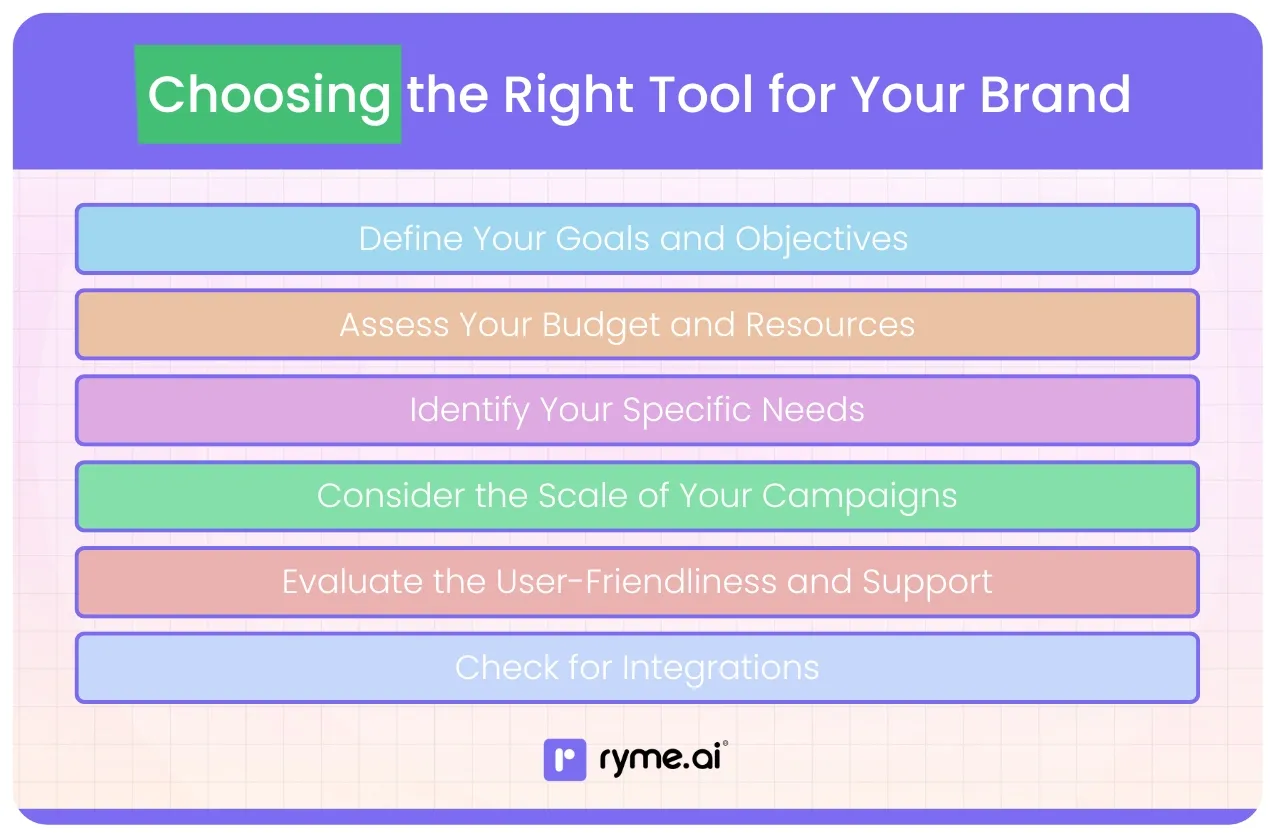
1) Define Your Goals and Objectives: What's Your 'Why'?
Before looking at any tool, get crystal clear on what you want to achieve with Instagram influencer marketing.
- Are you focused on building brand awareness and reaching a wider audience? You might prioritize tools strong in influencer discovery with broad reach metrics.
- Is your main goal driving traffic to your website or generating leads? Look for tools with robust link tracking, click-through rate (CTR) analysis, and potentially integration with web analytics.
- Are you aiming for direct sales and conversions? Tools offering conversion tracking, ROI calculation, and potentially affiliate features will be more relevant. Influencer Marketing Hub's 2023 data showed 'Increasing Sales' and 'Building Brand Awareness' were top objectives for marketers. Knowing yours helps narrow the focus.
- Do you need to manage product seeding or gifting campaigns? Ensure the tool supports managing logistics or tracking product sends.
Your Goal Dictates Your Need: Don't pay for features you won't use. Match the tool's strengths to your primary objectives.
2) Assess Your Budget and Resources: What Can You Realistically Invest?
Influencer marketing tools range widely in price, from free basic plans to enterprise-level solutions costing thousands of dollars (or lakhs of rupees) per month.
- Budget: Determine how much you can comfortably allocate specifically for the tool itself, separate from your influencer campaign budget. Consider different pricing models: monthly/annual subscriptions, pay-per-campaign, commission-based (like agencies, which ryme.ai avoids), or tiered pricing based on features/usage. Remember ryme.ai's zero-commission appeal here.
- Internal Resources: Who will be using the tool? Do you have a dedicated social media manager, a small team, or are you handling it yourself alongside other tasks? A complex tool might require significant time for onboarding and management. Consider the learning curve.
- Be Realistic: Choose a tool that fits your budget and your team's capacity to use it effectively.
3) Identify Your Specific Needs: Where's Your Biggest Pain Point?
Refer back to the tool categories. Where do you need the most help right now?
- Discovery: If finding the right influencers is your biggest hurdle, prioritize dedicated discovery platforms or all-in-ones with strong search and vetting capabilities.
- Management: If you're drowning in spreadsheets and emails trying to manage campaigns, focus on campaign management platforms or all-in-ones with robust workflow features.
- Analytics: If proving ROI and understanding performance is critical, prioritize analytics tools or all-in-ones with deep, reliable data tracking (like ryme.ai's Meta API integration).
- Combination: If you need help across the board, an all-in-one platform might be the most efficient solution.
- Prioritize Solutions: Address your most significant bottleneck first.
4) Consider the Scale of Your Campaigns: How Big Will You Go?
The complexity and volume of your campaigns impact the type of tool you need.
- Few Small Campaigns: If you're only running occasional campaigns with a handful of micro-influencers, a lighter, perhaps more affordable tool or even a combination of free/basic tools might suffice initially.
- Multiple Large-Scale Initiatives: If you're managing ongoing programs with numerous influencers, complex deliverables, and significant budgets, you'll need a robust platform (likely a comprehensive management or all-in-one solution) that can handle the scale and complexity without becoming cumbersome.
- Match Tool Power to Campaign Size: Don't use a sledgehammer to crack a nut, but don't bring a teaspoon to dig a foundation either.
5) Evaluate the User-Friendliness and Support: Can You Actually Use It?
A powerful tool is useless if your team finds it confusing or difficult to navigate.
- Intuitive Interface: Look for demos or free trials. Is the dashboard clean? Is it easy to find the features you need? Does the workflow make sense?
- Onboarding & Training: Does the provider offer help getting started? Are there tutorials, knowledge bases, or training sessions available?
- Customer Support: What happens when you run into a problem or have a question? Is support readily available (e.g., chat, email, phone)? What are their response times? Check reviews for feedback on support quality.
- Test Drive: Always try before you buy (or commit) if possible.
6) Check for Integrations: Does It Play Well with Others?
Your influencer marketing tool doesn't exist in a vacuum. Consider how it connects with your existing marketing stack.
- Social Media Platforms: Obviously, strong integration with Instagram is essential. Does it also support other platforms you might use (YouTube, Facebook)?
- E-commerce Platforms: If driving sales is key, does it integrate with Shopify, WooCommerce, etc., for better conversion tracking?
- CRM Systems: Can you sync influencer data with your main customer relationship management system?
- Email Marketing Tools: Any useful integrations for communication or list building?
- Analytics Platforms: Does it connect with Google Analytics for a holistic view of traffic and conversions?
- Think Holistically: Seamless integrations save time and provide a more unified view of your marketing efforts.
By thoughtfully considering these factors, you can move beyond the overwhelming number of options and choose an influencer marketing tool that truly empowers your brand on Instagram, fits your budget, and helps you achieve your specific marketing goals.
Conclusion
So, there you have it. Navigating the exciting possibilities of Instagram influencer marketing doesn't have to mean getting lost in manual tasks and guesswork. While the personal touch in building relationships remains vital, the right software acts as your indispensable co-pilot, handling the heavy lifting so you can focus on strategy and creativity.
We've seen how manual approaches can eat up your time, make it hard to verify authenticity, create campaign chaos, obscure your ROI, and lead to communication breakdowns. In contrast, dedicated influencer marketing tools bring efficiency, precision targeting, streamlined management, clear analytics, and smooth collaboration to the table.
Using these tools isn't about replacing the human element; it's about enhancing it. It frees you up to build stronger relationships, craft more compelling campaigns, and ultimately, achieve better results from your Instagram influencer marketing efforts. Time to ditch the spreadsheet stress and embrace the power of smart tools! 💪✨
Common Influencer Marketing Tools Related FAQs
Let's tackle some frequently asked questions about influencer marketing tools:
1) What are influencer marketing tools?
Influencer marketing tools are software platforms or applications designed to help brands and marketers streamline and optimize various aspects of their influencer marketing campaigns. They automate and improve processes like finding influencers, vetting their audience authenticity, managing campaign workflows (briefing, content approvals, communication), tracking performance metrics (reach, engagement, ROI), and reporting results. Essentially, they make influencer marketing more efficient, measurable, and scalable.
2) Which platform is commonly used for influencer marketing?
Instagram remains a dominant platform for influencer marketing globally, including in India. Its visual nature, diverse content formats (Posts, Stories, Reels), large user base, and strong engagement features make it highly attractive for brands across various industries. Consequently, most influencer marketing tools offer robust features specifically tailored for Instagram campaigns.
TikTok has also rapidly gained prominence, especially for reaching younger demographics, and many tools now support TikTok campaigns as well. YouTube is also a major platform, particularly for longer-form content and in-depth reviews. The "best" platform depends on the brand's target audience and campaign goals.
3) What is the best tool for finding influencers?
There isn't one single "best" tool, as the ideal choice depends on your specific needs and budget. However, strong contenders often include:
- Dedicated Discovery Platforms: Tools like Upfluence, Aspire (formerly AspireIQ), or Grin often receive high marks for their extensive databases, advanced search filters, and audience vetting capabilities.
- All-in-One Platforms with Strong Discovery: Platforms like ryme.ai stand out by using AI for more nuanced, data-driven matching beyond basic filters. Others like CreatorIQ or Mavrck also offer integrated discovery features.
- Things to consider: Look for tools with detailed audience demographics, reliable authenticity scores (fake follower detection), filters relevant to your niche and region (e.g., India-specific influencers), and potentially contact information or outreach features. Trying free trials or demos is the best way to see which interface and feature set works best for you.
4) Which is the most effective form of influencer marketing?
Effectiveness depends heavily on campaign goals, target audience, and execution. However, some general trends and considerations are:
- Authenticity & Long-Term Partnerships: Moving beyond one-off transactional posts towards building genuine, long-term relationships with influencers often yields better results. Audiences trust authentic recommendations.
- Micro- and Nano-Influencers: While mega-influencers offer broad reach, micro-influencers (typically 10k-100k followers) and nano-influencers (1k-10k followers) often boast higher engagement rates and a more dedicated, niche audience. They can be highly effective for driving targeted engagement and conversions, often at a lower cost. Influencer Marketing Hub's 2023 data confirms micro-influencers often have strong engagement.
- Video Content: Especially short-form video like Instagram Reels, is highly engaging and effective for storytelling, tutorials, and capturing attention quickly.
- Data-Driven Selection & Measurement: The most effective campaigns are those where influencers are carefully chosen based on data (audience alignment, authenticity) and performance is meticulously tracked to understand what works and optimize future efforts. Using tools significantly enhances this.
- Clear Call-to-Actions & Goals: Effective campaigns have clear objectives (e.g., drive traffic, use a discount code, sign up for a newsletter) and make it easy for the audience to take the desired action.
Ultimately, a multi-faceted approach, leveraging different influencer tiers and content formats based on data-driven insights and authentic partnerships, tends to be the most effective strategy.
Actionable Checklist / Key Takeaways:
Feeling ready to streamline your Instagram influencer marketing? Here’s your quick checklist:
✅ Acknowledge the Limits: Recognize the inefficiencies of purely manual influencer marketing (time drain, vetting issues, management chaos, ROI mystery, communication snags).
✅ Understand Tool Benefits: Appreciate how tools boost efficiency, improve targeting, organize campaigns, provide clear analytics, and streamline communication.
✅ Know the Tool Types: Differentiate between Discovery, Management, Analytics, and All-in-One platforms.
✅ Assess Your Needs:
- Define clear campaign goals (Awareness? Traffic? Sales?).
- Determine your budget for a tool (consider ₹!).
- Identify your biggest pain point (Finding? Managing? Measuring?).
- Consider your campaign scale (Small tests or large programs?).
✅ Evaluate Potential Tools:
- Check user-friendliness (Request demos/trials!).
- Verify the quality of customer support.
- Look for necessary integrations (Instagram API, E-commerce, Analytics?).
✅ Consider AI-Powered Options: Look into platforms like ryme.ai for advantages like AI-matching, zero commissions, deep analytics, and efficient workflows.
✅ Prioritize Data: Commit to using analytics to track performance, measure ROI, and make informed decisions.
✅ Start Smart: Choose a tool that fits your current needs and budget, knowing you can potentially upgrade or change as you grow.
